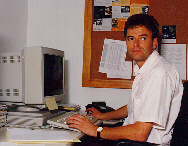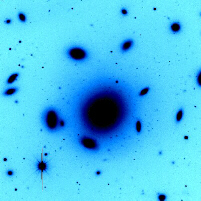From La Palma to the End of the Universe
 Chris Benn Chris Benn
In the autumn, a luminous band straddles the night sky -
the Milky Way. It can easily be seen from any place free of the
glare of street lights.
Through a telescope, the Milky Way's glow is resolved into
individual stars - thousands of millions
of them, lying in a vast plate-shaped
cloud we call the Galaxy.
Our sun is one of these stars, lying about half way out
from the centre of the Galaxy. The
Milky Way is our edge-on view of the Galaxy around us.
The Galaxy contains many other stars like our sun, some probably
circled by planets like the earth. From some of these planets,
perhaps, other inquisitive beings gaze out at the Universe.
In the 1920s astronomers realised that our island universe, the Milky
Way Galaxy, is not alone in space. Outside it are other galaxies,
each containing thousands of millions of suns.
One of these other galaxies is visible to the naked eye, as a faint fuzzy blob
in the constellation of Andromeda.
The Andromeda galaxy is similar in size and shape
to the Milky Way and is our galaxy's
nearest neighbour, 2 million light years (20000000000000000000000 km) away.
Further away are other galaxies, too faint for the eye to see.
With powerful telescopes, millions have been photographed.
Remarkably, all the galaxies are fleeing from one another:
the whole Universe is expanding.
This is one of the key pieces of evidence that about 15000 million years
ago, there was a beginning to the Universe, an immense explosion
we call the Big Bang. The debris from the explosion is still flying apart.
Earth is one of the cinders.
 |
A distant cluster of galaxies.
Each galaxy contains
about a 100000 million suns. |
Because each galaxy contains about 100000 million suns, galaxies can be seen
to enormous distances, and they light up the distant universe for us.
One of the questions we hope to answer by studying them is that of
the ultimate fate of the Universe. Will the expansion continue
forever, or will it be slowed down by the mutual gravitational attraction
of the galaxies and eventually reverse?
Either way the future for our descendants is bleak!
If the expansion continues forever, the matter in the Universe will
become more and more thinly distributed,
the suns will wink out one by one and the Universe will freeze.
If on the other hand the Universe stops expanding,
gravity will ensure that all the galaxies fall back together
in a spectacular Big Crunch, annihilating everything.
Fortunately, we don't have to worry about either fate for
20000 million years or so.
It turns out that asking whether or not the Universe will
expand indefinitely is the same as asking whether or not
the Universe is infinite in extent. If there is enough matter in the
Universe to eventually halt the expansion, there is also enough to
curve space around on itself, so that the Universe is not infinite.
(Curved space is hard to imagine, but is analogous to the
curvature of the earth's
surface. The earth's surface has no edge, but is not infinite
in extent.)
Astronomers are now close
to discovering which of these fates will befall our Universe.
We know how fast the Universe
is expanding. We have two ways of finding out whether it will continue
to expand or not. One is to
measure the amount of matter in the Universe, to see if there is enough gravity
to halt the expansion. The other is to measure directly how much the
expansion of the Universe is decelerating.
Measuring the amount of matter in the Universe involves estimating the masses
of galaxies.
Last week for example, a team of astronomers
from the Netherlands spent 4 nights at the William Herschel Telescope,
the largest on La Palma, taking photographs of large clusters of galaxies.
The photographs include slightly-distorted images of distant
galaxies behind
the clusters. The distortions are caused by the gravity of the cluster
of galaxies, which acts like a lens or distorting mirror. From the shape of the distortions, the masses of the clusters of
galaxies can be found.
The other approach, measuring the deceleration of the Universe, involves
a bit of time travel. On human timescales, the deceleration is much too small
to be noticed. But if we could measure the speed of expansion a few
thousand million
years ago, and compare it with the speed now, we would know how
much deceleration had taken place.
Fortunately, large telescopes can be used to peer far into the past.
The most distant galaxies that can be seen by the telescopes on La Palma
are some 13000 million
light years away, which means that the light we see them by
has taken 13000 million
years to arrive. We are seeing the galaxies as they were 13000 million
years ago.
In recent years, a joint US/European team have been using the La Palma
telescopes in this 'time-machine' mode, studying exploding stars
in extremely distant galaxies in order to measure their distances and the
speeds at which they are (were) receding from us.
These experiments are difficult, and require many years of work
with large telescopes. Gradually, however, a coherent picture is emerging,
and, thanks in part to the clear dark skies above La Palma, we shall soon
know the ultimate fate of the Universe.
|

